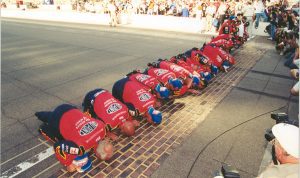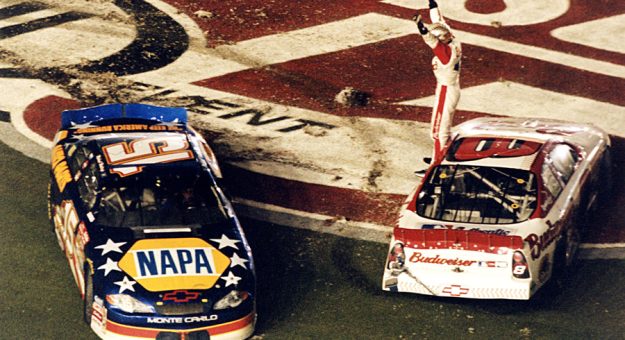Editor’s Note: NASCAR is celebrating its 75th anniversary. SPEED SPORT was founded in 1934 and was already on its way to becoming America’s Motorsports Authority when NASCAR was formed. As a result, we will bring you Part 54 of a 75-part series on the history NASCAR.
It was the most heart-breaking season in NASCAR history, but it was also one of the most triumphant.
While the death of Dale Earnhardt clouded the season, Jeff Gordon became only the third driver to win the Cup Series championship at least four times and 19 drivers visited victory lane.
Earnhardt was killed on the final lap of the Daytona 500 while the cars he owned driven by Michael Waltrip and his son, Dale Jr., raced to the checkered flag with Waltrip posting the first victory of his career. Earnhardt’s death created the greatest media scrutiny NASCAR had ever faced and left the sport without a seven-time champion and its greatest spokesman.
Gordon, who turned 30 during the season, stepped into the leadership role both on and off the race track. But it was on the race track where he and his Robbie Loomis-led Hendrick Motorsports team made it clear they were playing for keeps.
Gordon powered his DuPont Chevrolet to a 349-point victory over Tony Stewart, whose late-season charge aboard Joe Gibbs’ Home Depot Pontiac brought him to second in the chase. Gordon led the series in victories and poles, taking six triumphs to carry his career total to 58 in only nine years of competition.
He also captured seven poles.
The biggest victory of the season fur Gordon came in early August when he won the Brickyard 400 at Indianapolis Motor Speedway for the third time. The prestigious triumph coupled with a bad day by the other championship contenders, including Ricky Rudd, who had entered the race within shouting distance of Gordon for the point lead, was the turning point in Gordon’s run to the championship.
Gordon earned 18 top-five and 24 top-10 finishes in 36 races.
“Winning four championships-no matter what age you are-is mind-boggling,” Gordon said. “That’s why it’s going to take time to sink in. I’ve never been one to focus on age. All my life, I’ve been pushed to do things at a young age that nobody else had ever done before. I was racing sprint cars at age 13. I got my USAC license at age 16. You’re supposed to be 18.
“So I was always one step ahead of the other guys as far as age. I always looked at it that if you are capable and in the right situation and equipment, it doesn’t matter what age you are.
“So as I get older, I appreciate the things that I’ve accomplished at a young age even more. When I look back at this year, turning 30 can be one of those birthdays that really get you down. But for me, it’s been a spectacular year.”

Stewart drove his Greg Zipadelli-wrenched machine to 15 top-five and 22 top-10 efforts, including a pair of victories.
One of Stewart’s two victories came on the road course at California’s Sonoma Raceway.
Dodge made its return to Cup Series racing after more than 20 years and while the nameplate struggled early, Sterling Marlin enjoyed the best year of his career, wheeling an Intrepid for Chip Ganassi Racing.
Marlin gave Dodge its first victory of the season in a rain-shortened event at Michigan Int’l Speedway in August. Marlin added a second victory at Charlotte Motor Speedway in October. Dodge won two additional races with drivers Ward Burton and Bill Elliott, who returned to victory lane for the first time since 1994 when he won at Homestead-Miami Speedway.
Marlin posted 12 top fives and 20 top 10s, while finishing third.
Rudd got off to a slow start and had an even slower finish as his Robert Yates Racing team was plagued by several mechanical failures down the stretch and fell to fourth in the final standings after challenging during the middle portion of the season.
Rudd won twice in his Texaco-Havoline Ford and picked up 14 top-five and 22 top-10 finishes. Dale Jarrett, Rudd’s RYR teammate also had a strong start to the season, but struggled with injuries and poor performance during the middle of the season, dropping him to fifth in the standings despite four victories, 12 top fives and 19 top-10 efforts.
It was Jarrett’s worst points finish in seven years.
Defending champion Bobby Labonte struggled early in the season, but a strong second half brought his team to sixth in points with a pair of victories. Jeff Gordon was the only driver to lead more laps than Rusty Wallace, but still Wallace won only one race and finished seventh in points.
With the most difficult task of any Winston Cup driver, Dale Earnhardt, Jr. had a stellar sophomore season. Having to cope with the loss of his father, as well as added burdens of fulfilling many of his dad’s business commitments, Earnhardt won three races and finished eighth in the standings.
His biggest victory came in the Pepsi 400 at Daytona Int’l Speedway in July as the series returned to the superspeedway for the first time since the elder Earnhardt’s death. It was one of the most ruckus and emotional celebrations of the season.
When Earnhardt was killed, Busch Series regular Kevin Harvick was thrust into the most difficult situation one could imagine, replacing a legend. The Kid handled the situation masterfully, winning in only his third race at Atlanta Motor Speedway in March. The victory gave Richard Childress Racing, and the sport as a whole a huge lift.
Harvick added a second victory in the inaugural race at Chicagoland Speedway and finished ninth in points despite only running 35 of the 36 races. Harvick also garnered the Raybestos Rookie of the Year title and captured the NASCAR Busch Series championship as he ran full time in both series.
Finally, Jeff Burton struggled mightily through the season, but fought to 10th in standings with two victories.
With 19 drivers visiting victory lane, there were many first-time winners.
After Harvick won for the first time in March, Elliott Sadler put the Wood Brothers back invictory lane with his first Cup Series triumph at Martinsville (Va.) Speedway. Waltrip won his first race in the Daytona 500 and Ricky Craven scored one of the most popular victories of the season, giving team owner Cal Wells his first Cup Series victory.
Finally, Robby Gocdon, who has had a tumultuous stock car career, bumped Jeff Gordon out of the way to post his first victory in the season finale at New Hampshire Motor Speedway, as the race was held the day after Thanksgiving after being postponed because of the Sept. 11 terrorist attacks.
Other winners were Joe Nemechek, Bobby Hamilton and Steve Park.
NASCAR’s new television agreement with FOX and NBC brought numerous new fans and record television ratings in a year that will be remembered more for the loss of a legend than the growth of a sport.
